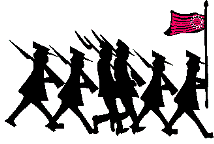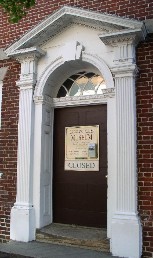|
The Federal Style in the New World
Federal Style 1780-1830
It was a new world! New opportunities had come through the setteling of the colonies and The new United States wanted to prove to the world that they were strong, intelligent, and determined as individuals, society, and state. The Republic, Democracy & Architecture, Its leaders believed they would lead the world into progress. From a period of tradition, irrationality, superstition, and tyranny they believed that society would be improved by reason, logic and freedom of religion. Science, study and nationality became important to the developing states.
>
The Federal style (or Federalist style) has its roots in England. Even though the war of independence changed the political stage, English influences on architecture continued. Two British brothers named Adam enhanced the square, angular Georgian style of England by adding swags, garlands, urns, and other delicate details inspired by the great temples of ancient Greece and Rome. New America homes and public buildings took on more graceful airs. This new Federal style became associated with America's evolving national identity. The official, civil and religious architecture reflected this vision and took the Acropolis buildings as a model. The buildings of these new federal and judicial institutions adopted the classic columns, domes and pediments.
These architects are known for their Federalist buildings: .William Thorton .Charles Bulfinch in Boston, .Benjamin H. Latrobe in Philadelphia and Virginia, .Gabriel Manigault in Charleston, South Carolina, .William Jay in Savannah, Georgia, .John McComb in New York, .Samuel McIntire in Salem, Massachusetts .Alexander Parris in Maine.
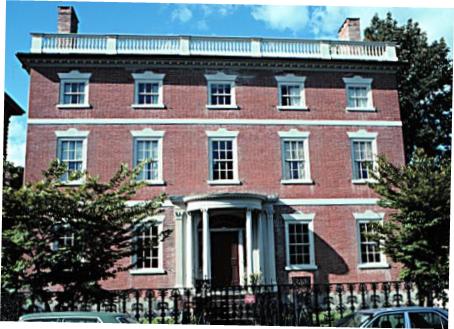
It's easy to confuse Federalist architecture with the Georgian Colonial Style. The difference is in the details and adornments. Federal style is a Georgian Style with Adamesque enhancements. The main identifying feature is typically the fanlight entryway with classical columns and Palladian windows. Georgian homes are square and angular, a Federal style building is more likely to have curved lines and decorative flourishes. Federal style details are often incorporated into modern American homes. The faces of many vinyl clad homes have an extended gabled porch roof supported with columns and the front door with a fanlight above and the elegant arch of Palladian windows to the sides. Characteristics of the Federal style include bright interiors with large windows. The interiors having white walls and ceilings, and a decorative yet restrained appearance that emphasized rational elements. This North American variation on Palladian architecture revived the portico. This interest in Roman elements appealed in a political climate that looked to the Ancient Roman Republic as a model. Architectural publications multiplied: in 1797, A very popular book to influence local carpentry was Benjamin Asher's "The Country Builder's Assistant". .
American Federal houses have many of these features: .Classical/Greek detailing of entryway, an entrance topped by a pediment supported by Doric columns .Decorative crown or roof over front door often with a balustrade .Semicircular fanlight over the front door .Narrow sidelights flanking the front door
.Windows arranged symmetrically around a center doorway .Palladian windows (tall circle head sash flanked by smaller rectangular openings) .Shutters .Low-pitched roof, or flat roof with a balustrade .Oval or circular rooms in some highend homes .Interior arches .Symmetrical and angular as in the Georgian style .Windows: double-hung sash double hung windows placed symmetrically in brick walls and topped with flat stone lintels .Tooth-like dentil moldings in the cornice .Decorative swags and garlands above doors and windows on the interior and/or exterior
Mount Vernon, Residence of George Washington, Georgian style T “Architecture is worth great attention,” Jefferson declared, “As we double our numbers every twenty years, we must double our houses . . . It is then, among the most important arts; and it is desirable to introduce taste into an art which shows so much.”
Up and down the East Coast, Federal-style architecture dates from the late 1700s and coincided with a reawakening of interest in classical Greek and Roman culture. Builders began to add swags, garlands, elliptical windows, and other decorative details to rectangular Georgian houses. The style that emerged resembles Georgian, but is more delicate and more formal. Many Federal-style homes have an arched Palladian window on the second story above the front door. The front door usually has sidelights and a semicircular fanlight. Federal-style homes are often called “Adam” after the English brothers who popularized the style.
FEDERAL 1790-1820 Urban style
A distinction is made between public buildings and Federal urban dwellings.
After America won its independence there was a strong national desire to create a distinctly American identity in architecture. There was a desire for comfort, quality and dignity.
The Federal style was especially popular in the South and was far more elaborate than the New England version which tended to be modest. The grand homes in the South were built by wealthy people who hired European architects and considered themselves aristocrats.
Paint colors were limited, the most popular being yellow, ochre, or white. Outbuildings and even the nonpublic side of more important buildings often were painted red, the most economical paint color for the period.
|





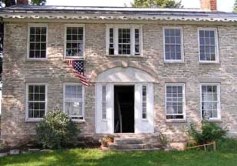
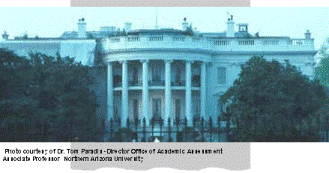 New institutions needed to be established. Government, Banking, universities, trading centers… Architecture was the visual of the philosophy of independence, strength and new traditions. The architecture they chose is called Federalist.
New institutions needed to be established. Government, Banking, universities, trading centers… Architecture was the visual of the philosophy of independence, strength and new traditions. The architecture they chose is called Federalist. 